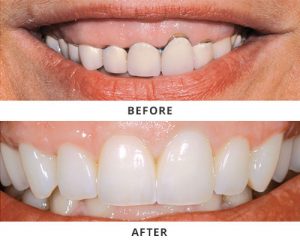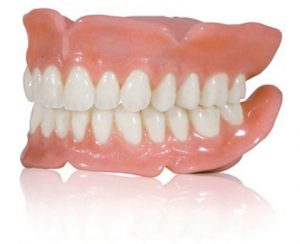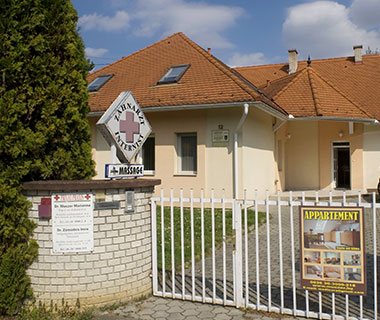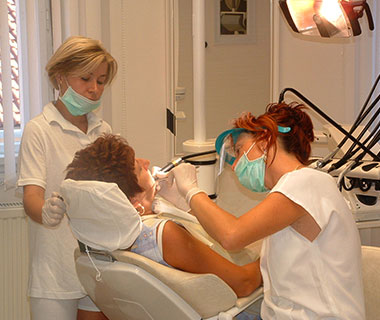Prosthetics
Tooth replacements
Crowns
 Tooth replacement, covering the whole denture, is made if there are too many missing teeth or a crown is to placed on root canal treated teeth that must be protected from fractures. Crowns can give back the original form, function and colour of the tooth. The materials of crowns can be: porcelain burnt on metal and zirconium.
Tooth replacement, covering the whole denture, is made if there are too many missing teeth or a crown is to placed on root canal treated teeth that must be protected from fractures. Crowns can give back the original form, function and colour of the tooth. The materials of crowns can be: porcelain burnt on metal and zirconium.
Porcelain crowns burnt on a metal cap
They consist of a metal cap and there is burnt porcelain on it. The metal cap is strong, it is resistant against the bites, it does not fracture. They burn porcelain on it to make it aesthetic.
Zirconium crowns
The zirconium crown is similarly resistant to metal-porcelain crowns but as far as aesthetics it outperforms porcelain crowns. The main difference between the two is that the metal cap is grey but the zirconium one is snow-white. After a while the gum tissue can draw back a few mms that’ s why the grey grim of the metal-porcelain crown can become conspicuous. In case of having zirconium crown this problem does not occur. The zirconium is tissue friendly, irritates the gum less, it is not conductive so the thermo effects due to conduction can be prevented. Considering the information above we can say that the highest quality replacements can be made from zirconium today.
The average lifespan of a crown is 8-10 years. With proper oral hygiene and dentist control this period can be increased. The lifespan of a crown may be highly decreased by wrong oral hygiene and bad habits: chewing the nails, ice-cube or sugar.
Bridges
If there are one or more teeth missing we prepare a bridge to eliminate the gap. The bridge consists of the crowns and false teeth, which are filling the gaps. Their material can be made from metal-porcelain or zirconium like in the case of crowns.
While preparing the bridge the dentist polishes the supporting-teeth as much as the supporting-crown demands so that the technician can prepare the bridge. After that a study model is taken and according to this model the technician can make the bridge.
During the next appointment, if both the patient and the dentist find the replacement correct, the bridge is getting fixed.
Partial dentures
Partial removable denture
 Partial denture is fabricated when the patient still possesses some teeth, however not enough in numbers or not properly positioned. In this case the replacement is extended not just on the teeth but also on the mucous membrane. Partial dentures can be connected to teeth by metal clasps or by aesthetic precision attachments such as a slider, pier or telescope crown. These solutions mean not only aesthetic advantages but also they give a more stable, safer fixing of the partial denture to the own teeth.
Partial denture is fabricated when the patient still possesses some teeth, however not enough in numbers or not properly positioned. In this case the replacement is extended not just on the teeth but also on the mucous membrane. Partial dentures can be connected to teeth by metal clasps or by aesthetic precision attachments such as a slider, pier or telescope crown. These solutions mean not only aesthetic advantages but also they give a more stable, safer fixing of the partial denture to the own teeth.
Full denture
 A full denture is only fabricated when the patient is missing all of the original teeth. This is not only restores the chewing function but has an aesthetic effect, as well; it supports the muscles of the face and lips, makes you look younger. It does not allow you to have a pinched face, it will give you a beautiful smile.
A full denture is only fabricated when the patient is missing all of the original teeth. This is not only restores the chewing function but has an aesthetic effect, as well; it supports the muscles of the face and lips, makes you look younger. It does not allow you to have a pinched face, it will give you a beautiful smile.
The denture can be strange and uncomfortable at first and you need a strong will to get accustomed to this medical prosthesis and learn how to speak and chew with it. This denture is lying on the mucous membrane and its endurance depends on the person. This is why the patients have to go back to the dentist after receiving the denture – a few times, depends on the person again – for eliminating the sore gum.
Since the denture is completely removable any time, it is up to the patient whether he can accept it, can get used to it.
At first the fitting of the denture might seem loose until the facial muscles and the tounge learn to use it. Sensitive areas of the gum might become sore. Oral mucus might be generated in a higher quantity. These symptoms will disappear later.


